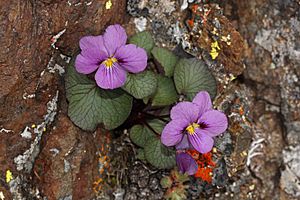Olympic violet facts for kids
Quick facts for kids Olympic violet |
|
|---|---|
 |
|
| Conservation status | |
| Scientific classification | |
| Genus: |
Viola (plant)
|
| Species: |
flettii
|
The Viola flettii, also known as the Olympic violet, is a special type of violet. It grows only in the northeastern and eastern parts of the Olympic Mountains in Washington.
This plant likes rocky areas and loose slopes called talus. You can find it high up in the mountains, from about 1,340 to 2,000 meters (4,400 to 6,560 feet) above sea level. It blooms during the summer, usually from June to August.
Contents
What is the Olympic Violet?
The Olympic violet is a small plant that grows from an underground stem called a rhizome. It can reach a height of a few centimeters up to about 15 centimeters (6 inches). Its stems are smooth and do not have hairs.
How Does it Look?
The leaves at the bottom of the plant are shaped like kidneys and are green with purple veins. They grow on long stalks. The leaves on the flower stem are similar but smaller.
Each flower grows on its own thin, upright stem. The flowers have five petals that are purplish-violet with yellowish parts near the center. The three lower petals have purple veins. The two side petals and the plant's stigma (the part that receives pollen) have small hairs. A small pouch called a spur is found on the lowest petal, but it is much shorter than the petal itself.
Why is the Olympic Violet Special?
The Olympic Mountains are part of the Pacific Coast Ranges in North America. During the last ice age, this area was like a safe haven, or refugium, surrounded by ice. This made it a unique place for plants to survive.
The Viola flettii is one of seven plant species that are found only in the Olympic Mountains. This means they are endemic to this specific area and grow nowhere else in the world.
Is the Olympic Violet in Danger?
The Olympic violet is considered a vulnerable species, meaning it needs protection. It is listed on the Watch List of Vascular Plant Species by the Washington Natural Heritage Program.
Most of these plants are protected inside Olympic National Park or near its edges. Other groups are found in the Olympic National Forest. Many of these plant groups are quite small. For example, in 2001, only 20 plants were counted on Mount Townsend, and just eight on Mount Ellinor.
One possible threat to the Olympic violet comes from mountain goats. These goats were brought to the Olympic Mountains in the late 1920s. They eat plants, and this can harm the small groups of Olympic violets.


